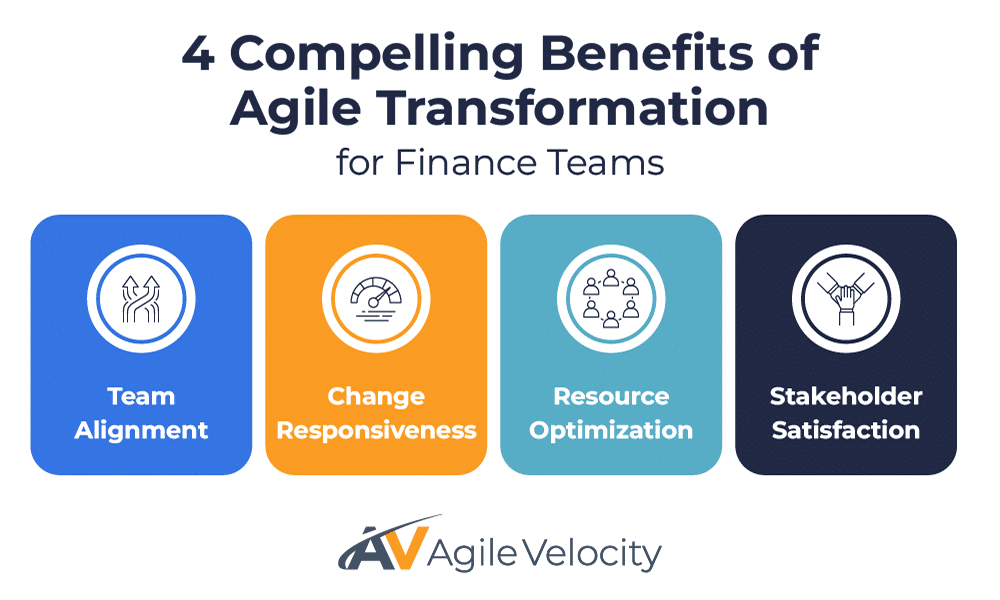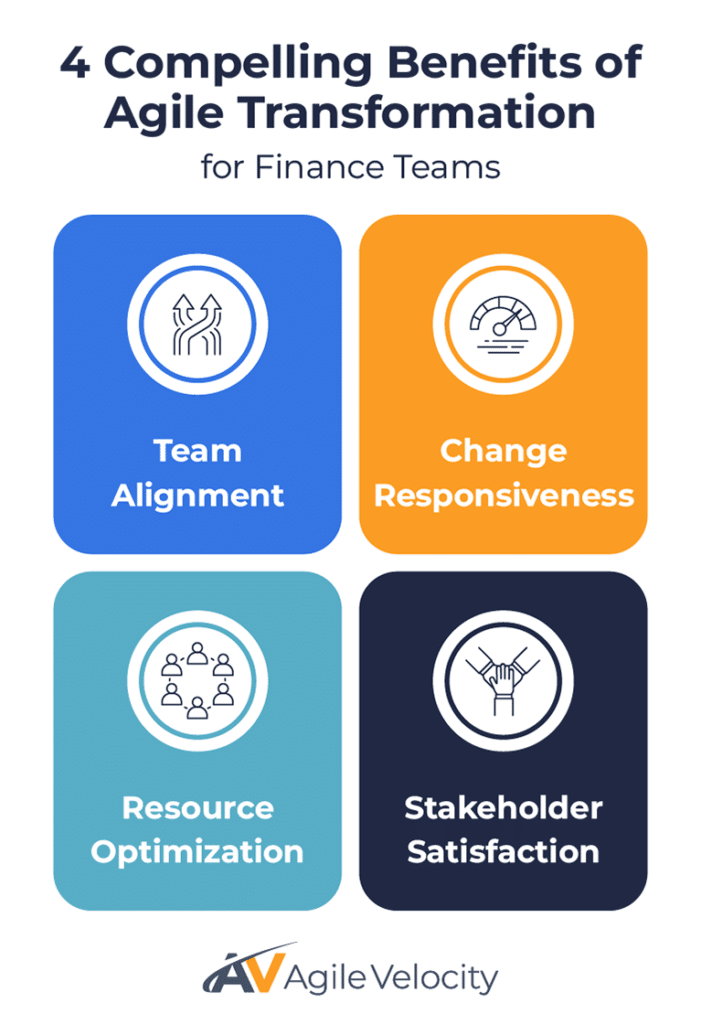Managing financial operations demands a balance of precision, compliance, and adaptability. With evolving customer expectations and technological advancements, finance teams are under increasing pressure to deliver value faster, without compromising on accuracy. Agile Transformation provides a structured yet flexible approach to streamlining workflows, fostering collaboration, and improving efficiency in financial organizations.
In this article, we explore
- The key challenges Finance teams face and how Agile helps overcome them.
- Practical strategies to transition from traditional finance methods to Agile practices.
- The role of Path to Agility® Navigator in tracking and optimizing Agile progress.
Ready to transform your financial operations? Let’s look into how Agile principles can reframe financial organizations as high-performing, value-focused teams.
Transforming Financial Operations with Agile Principles
Financial operations often face the dual challenge of maintaining precision and complying with rigid regulatory frameworks while meeting demands for flexibility and innovation. Traditionally viewed as cost centers focused on risk avoidance and oversight, finance teams are increasingly exploring Agile Transformation to evolve into strategic, value-driven contributors. For instance, modern teams are now accessing deeper insights into financial operations to inform smarter decision-making.
By embracing Agile Methodologies, financial organizations can better identify inefficiencies, streamline processes, and deliver meaningful results more rapidly. Agile principles such as iterative improvement, enhanced collaboration, and adaptability are especially beneficial in overcoming constraints imposed by outdated systems, fragmented communication channels, and inflexible workflows. An Agile approach enables finance teams to adjust swiftly in response to market or regulatory changes, manage risks more effectively, and foster integrated efforts across departments.
This article examines how Agile practices address common challenges in financial operations and highlights the evolving role of tools in supporting a comprehensive transformation journey.
Key Obstacles in Financial Operations

Financial operations face several unique challenges as they strive to maintain accuracy, meet compliance standards, and operate efficiently under tight resource constraints. Key obstacles include:
Balancing Precision and Agility
Finance teams must ensure flawless accuracy in data and reporting while also responding quickly to shifting market conditions. This dual mandate often results in rigid workflows that can impede adaptability.
Managing Limited Resources and Competing Priorities
From budgeting to portfolio tracking, finance teams must constantly prioritize. Without a robust framework, resources may be misallocated, leaving high-impact initiatives under-supported.
Navigating Stakeholder Expectations
Internal and external stakeholders demand timely, high-quality outputs. Meeting these varied, and sometimes conflicting, stakeholder expectations can challenge even established processes.
Dealing with Legacy Systems
Outdated technology often lacks modern integration and scalability, causing inefficiencies and siloed data that complicate process improvement.
Adhering to Complex Compliance Mandates
Strict standards require thorough oversight at every step of financial processes. Embedding compliance into each strategy can slow efforts to innovate and adapt.
Overcoming Cultural Resistance to Change
Traditional mindsets can make it challenging for finance teams to embrace dynamic Agile methods. Resistance often stalls new practices, despite clear long-term benefits.
Agile encourages a culture of continuous improvement, turning these challenges into opportunities for streamlining workflows and promoting cross-functional collaboration.
Core Principles of Agile Transformation in Finance
Agile Transformation in finance centers on adaptability, collaboration, and incremental value delivery. These core principles reimagine financial operations as more responsive, aligned, and innovative:
- Collaboration Across Departments for Seamless Communication- Financial operations intersect with nearly every business function. Regular Agile events, such as a Daily Scrum, help identify and resolve blockers quickly.
- Transparency and Informed Decision-Making – Agile promotes a culture where all stakeholders have access to real-time insights. Visualization tools like Kanban Boards enable finance teams to monitor progress at a glance.
- Delivering Incremental Value Continuously – Rather than waiting for a long project cycle, Agile encourages smaller, iterative rollouts. In finance, this can involve phased improvements in reporting systems, budgeting practices, or workflow automation. This approach is exemplified by the benefits of incremental delivery.
- Embracing Continuous Feedback for Growth – Frequent feedback ensures that financial processes are reviewed regularly. By incorporating input from auditors to executive leadership, teams can constantly adapt.
- A Focus on Adaptability and continuous improvement – Agile Transformation instills a mindset of learning. Finance teams are encouraged to test new ideas, reflect on outcomes, and adjust strategies—supported by iterative improvement.
Incorporating Agile Transformation principles within financial operations cultivates a forward-thinking environment where adaptability and collaboration flourish. By fostering seamless communication across departments, finance teams can swiftly address obstacles and ensure all stakeholders are aligned through transparency and informed decision-making.
Emphasizing incremental value delivery helps financial organizations move beyond cumbersome, long-term projects in favor of more frequent and meaningful improvements, enhancing overall operational efficacy. The integration of continuous feedback loops further enables teams to remain nimble and responsive to changes or new insights. Ultimately, a culture that prioritizes agility and continuous improvement not only reinforces financial precision and compliance but also positions finance teams as pivotal contributors to strategic organizational success.
Four Reasons Financial Organizations Benefit from Agile Transformation
Adopting Agile Transformation unlocks multiple advantages for finance teams:
1) Enhanced Team Alignment and Transparency
Frameworks such as SAFe®, Lean Portfolio Management, and Scrum foster better coordination, making sure operational activities align with broader business goals.
2) Improved Responsiveness to Change
Agile practices enable rapid adaptation when regulatory changes or market disruptions arise. Shorter planning cycles and iterative deliveries empower finance teams to tackle unexpected challenges effectively.
3) Optimized Efficiency and Use of Resources
Incremental work cycles help identify process bottlenecks early and reduce wasteful efforts. Teams can then allocate resources to high-value initiatives.
4) Increased Stakeholder and Client Satisfaction
Delivering results incrementally improves internal processes and builds stakeholder confidence. Timely reporting, clearer forecasting, and streamlined data management demonstrate a commitment to continuous improvement.
Through these four pillars, Agile Transformation equips financial organizations with the agility to manage evolving demands and the precision to optimize their operations. By emphasizing alignment, responsiveness, and resource optimization, financial teams not only enhance their internal processes but also drive greater stakeholder satisfaction, setting a strong foundation for sustainable growth and innovation in a dynamic market landscape.
Real Gains in Risk Management and Data Integrity
By adopting Agile Transformation, finance teams not only accelerate their responsiveness to market changes, but also gain stronger oversight in risk management. In a typical finance function, ensuring data integrity is paramount—especially when handling large volumes of transactions daily. Agile-driven processes create short iterative cycles that allow teams to constantly validate data accuracy and address potential issues before they escalate. Risk management becomes more proactive, as real-time visibility across workflows helps identify emerging threats earlier. With clearly defined roles, consistent communication, and integrated compliance phases, oversight is embedded in each stage of a project rather than considered a final requirement.
This holistic view of risk, combined with ongoing feedback loops, empowers financial leaders to refine audit processes, confidently close financial periods sooner, and invest in strategic initiatives that drive long-term growth. By keeping data integrity at the forefront of every iteration, finance professionals can ground business decisions in reliable information while maintaining adaptability in evolving markets.
Transitioning from Traditional Methods to Agile Practices
Embracing Agile does not mean discarding structure. Instead, it adds flexibility to meet evolving market and regulatory conditions. Starting small and scaling gradually helps finance teams maintain precision and compliance while gaining speed and adaptability. Financial organizations often rely on predictable, linear processes aimed at precision and compliance. However, modern markets demand more adaptive approaches. Transitioning to Agile involves:
Gaining Leadership Alignment and Support
Successful Agile Transformation starts with senior leadership. Their support sets the cultural tone and ensures resources are available.
Starting Small with Pilot Team
Implementations can begin with low-risk pilots. For example, a focused pilot team might adopt Scrum in one part of the finance function. Early wins build confidence for broader adoption. Many organizations rely on pilot teams to accelerate the transformation process.
A pilot team focuses on processes like invoicing and reconciliation by adopting Sprints with clear goals. Each Sprint concludes with a Sprint Review and a Sprint Retrospective to gather feedback and drive incremental improvements. Early wins, such as faster processing and fewer errors, spark enthusiasm for broader Agile adoption.
Implementing Agile Frameworks Effectively
While Scrum supports team-level enhancements, SAFe, and Lean Portfolio Management ensure that strategic goals align with operational activities. For example, adopting guidance for a SAFe Agile Transformation helps coordinate Agile practices at an enterprise scale. This balanced approach preserves precision as Agile practices reshape the finance function.
Building Compliance into Agile Processes
Including compliance steps early in backlogs integrates oversight naturally. This fusion maintains the balance between innovation and regulatory adherence. As iterative improvements and open communication take hold, finance operations become faster and more efficient. The department evolves from a static, compliance-focused unit to a strategic partner capable of timely insights and collaboration.
Addressing Cultural Resistance with Training and Communication
An Agile shift is significant for traditionally structured finance teams. Training and transparent communication about tangible outcomes—like faster reporting cycles and improved accuracy—help mitigate cultural pushback. Agile Transformation opens doors to greater efficiency, transparency, and adaptability. As teams address cultural resistance to change, they move closer to a finance function that actively contributes to strategic success.
Transitioning from traditional methods to Agile practices is not merely a process change, but a cultural evolution that empowers finance teams to cultivate innovation while maintaining compliance. By embedding Agile frameworks seamlessly within financial operations, organizations not only enhance efficiency but also foster a proactive, resilient climate that is well-equipped to adapt to the rapidly changing market landscape. This transformation paves the way for sustainable growth, enabling financial institutions to stay competitive and relevant in a dynamic business environment.
Tools and Techniques for Strengthening Agile in Financial Operations
Embedding Agile in financial operations can be reinforced by key tools and approaches:
- Agile Coaching for Lasting Change – Skilled coaches guide teams to embed Agile strategies into everyday finance tasks, ensuring a sustainable transformation.
- Lean Portfolio Management for Strategic Alignment – At the portfolio level, Lean principles help finance teams continuously prioritize projects based on measured value. See more on Lean Portfolio Management.
- SAFe for Scaling Agile in Complex Finance Teams – For larger organizations, SAFe coordinates multiple teams around shared goals, which is particularly useful in finance departments handling cross-functional initiatives.
- AI Solutions for Automating Routine Tasks – Integrating machine learning capabilities can help finance teams reduce errors and accelerate end-to-end operations, freeing team members for high-value analytical work.
These tools and techniques not only enhance the efficiency and agility of financial operations but also foster a culture of continuous improvement. By seamlessly integrating these methods, finance teams can ensure their strategies remain competitive and adaptable in a constantly evolving market. Adopting a combination of Agile frameworks, digital tools, and expert guidance solidifies an organization’s commitment to innovation and excellence in financial services.
How Path to Agility Navigator Supports Financial Agile Transformations
Successfully leading an Agile Transformation requires a new way of thinking and reliable tracking tools. Agile Velocity’s Path to Agility approach aims to streamline Agile Transformation by providing a structured process for organizations to navigate and implement change effectively. Path to Agility Navigator is a software designed by the experts at Agile Velocity to offer clear visibility into Agile efforts across varied industries by:
Visualizing Progress for Better Alignment
Path to Agility Navigator provides real-time dashboards that display milestones and focus areas. This transparency helps leaders communicate progress to stakeholders and stay aligned with strategic objectives.
Supporting Accountability and Measurable Improvements
By tying incremental changes back to business outcomes—like operational predictability—Path to Agility Navigator promotes data-driven improvements.
Ensuring Adaptive Transformation
Ongoing tracking and periodic adjustments keep even the most complex Agile undertakings on course. For finance teams, this includes integrating workflows with compliance measures.
The Path to Agility Navigator enhances this approach by offering real-time insights and progress tracking through its comprehensive dashboards, enabling teams to stay aligned with strategic goals while continuously optimizing their transformation journey. By integrating metrics and reflection points, the tool ensures finance teams incorporate compliance and stakeholder feedback seamlessly into their Agile processes.
A Guided and Sustainable Transformation for Finance Operations

Agile Transformation empowers financial teams to enhance adaptability, collaboration, and efficiency—without compromising the precision and compliance that finance demands. By adopting frameworks such as Scrum, SAFe, and Lean Portfolio Management, organizations can replace outdated processes with dynamic, value-driven approaches. Combining these practices with Path to Agility Navigator ensures that each phase is measurable and aligned with strategic goals.
Financing the future means moving beyond rigid structures to deliver faster, more accurate outcomes, and fostering a mindset of continuous improvement. Ready to lead the change? Explore more about Agile Velocity’s services and contact us for a consultation to begin your journey toward tomorrow’s finance reality.





